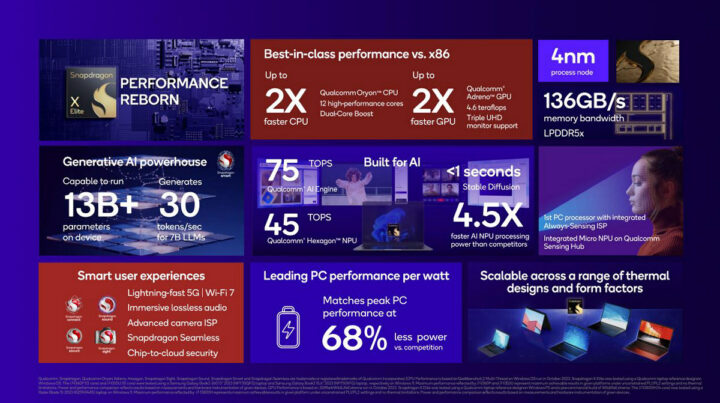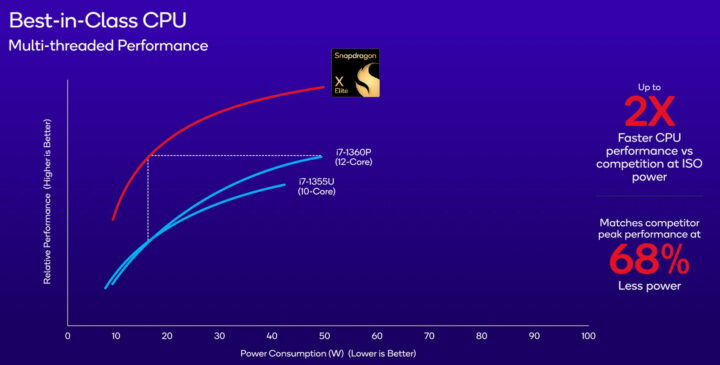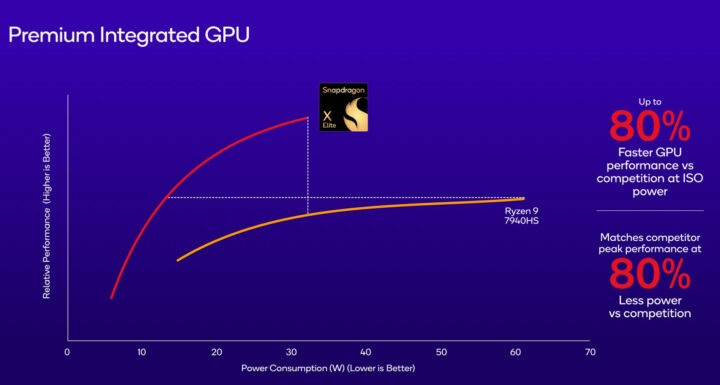Qualcomm has now provided Arm chips for mobile PCs (aka laptops) for several years, but apart from a 20-hour battery life, the performance and price of Snapdragon laptops have often been disappointing. The Snapdragon X Elite aims to change that at least on the performance front.
The new Qualcomm 12-core 64-bit Arm processor is clocked at up to 3.8 GHz boosting to up to 4.3 GHz, and is said to deliver up to twice the CPU performance against the competition (Intel/AMD/Apple) or provides the same level of performance at a third of the power consumption. The SoC will also be able to run on-device generative AI with over 13B parameters thanks to 75 TOPS of AI performance and support the latest wireless connectivity technologies such as 5G and WiFi 7 through external chips from the company.
Qualcomm Snapdragon X Elite specifications:
- CPU – 12-core 64-bit Armv8 Oryon processor clocked at up to 3.8 GHz, or 4.3 GHz for single or dual-core boost
- GPU – Adreno GPU up to 4.6 TFLOPs, DX12 API support
- NPUs
- Hexagon NPU with up to 45 TOPS
- Dual micro NPU on the Qualcomm Sensing Hub
- Up to 75 TOPS in total when combining CPU, GPU, NPU, and micro NPU
- Up to 30 tokens per second for 7B LLMs
- VPU – Adreno VPU
- Encode – 4K60 10-bit encode H.264, HEVC (H.265), AV1
- Decode – 4K120 10-bit decode H.264, HEVC (H.265), VP9, AV1
- Concurrency – 4K60 decode H.264, HEVC (H.265), VP9, AV1 and 2x 4K30 encode H.264, HEVC (H.265), AV1
- Memory – Up to 64GB 8-channel LPDDR5x with 136GB/s bandwidth
- Storage
- NVMe SSD over PCIe Gen 4
- UFS 4.0
- SD v3.0
- Video Interfaces
- eDP v1.4b up to UHD120 (4Kp120) with HDR10
- DP v1.4 for up to 3x displays with to 4Kp60 resolutions with HDR10, or 2x displays up to 5Kp60
- Camera
- Qualcomm Spectra ISP – Dual 18-bit ISPs and always-sensing ISP
- Dual Camera support up to 2x 36 MP
- Single Camera up to 64 MP
- Video Capture up to 4K HDR
- Audio – Qualcomm Aqstic audio, Qualcomm aptX audio
- Wireless connectivity using external chips
- FastConnect 7800
- Tri-band WiFi 7, WiFi 6E, WiFi 6 with up to 4 spatial streams
- Bluetooth 5.4
- Implemented through a WiFi M.2 card over PCIe Gen 3
- Cellular via Snapdragon X65 5G modem-RF system
- Supported features – 5G NR, mmWave, sub-6 GHz, Dynamic Spectrum Sharing (DSS), LTE, CBRS, HSPA, WCDMA
- Peak speeds – Download: 10 Gbps; upload: 3.5 Gbps
- 1,000 MHz bandwidth (mmWave), 300 MHz bandwidth (sub-6 GHz)
- Technologies – Qualcomm Smart Transmit technology, Qualcomm Wideband Envelope Tracking, Qualcomm AI-Enhanced Signal Boost adaptive antenna tuning, Qualcomm 5G PowerSave
- Implemented through a 5G M.2. card over PCIe Gen 3
- FastConnect 7800
- USB – 3x USB Type-C interfaces with support for USB4, USB 3.2 Gen 2, and eUSB2 (Embedded USB 2.0)
- Process – 4nm
Since the GPU only supports the DX12 API, I suppose that means Qualcomm will only support Windows 11 for the Snapdragon X Elite, so any Linux port would have to come from the community. It looks like quite a powerful chip even though the company is not quite explicit with its comparison against competing chips from public information.
But Anandtech has a few slides that chart the CPU performance against Intel Core i7-1360P and Core i7-1355U Raptor Lake processors…
… and the GPU performance against an AMD Ryzen 9 7460HS.
Both CPU and GPU results are really impressive, but the actual performance will ultimately depend on the power limits set in the target device which should be lower in laptops than in mini PCs (if any) in order to extend battery life.
Laptops powered by the Snapdragon X Elite processor are planned for mid-2024, so they would be matched against systems based on Intel Meteor Lake, AMD Ryzen 7000, and Apple’s next-gen M-series chip. You can also check out the product page and/or read the press release for more details.

Jean-Luc started CNX Software in 2010 as a part-time endeavor, before quitting his job as a software engineering manager, and starting to write daily news, and reviews full time later in 2011.
Support CNX Software! Donate via cryptocurrencies, become a Patron on Patreon, or purchase goods on Amazon or Aliexpress








